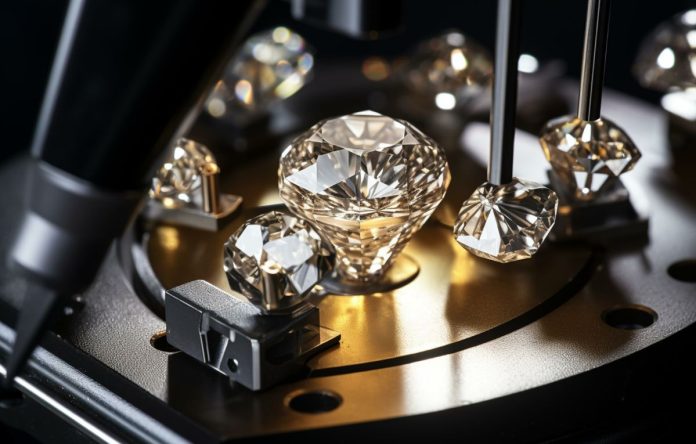As sustainability and ethical sourcing become essential in the jewelry industry, lab diamonds offer a responsible and innovative alternative to traditional mining. These diamonds, identical in beauty and structure to mined ones, present a solution to the environmental and ethical issues plaguing the conventional diamond industry. Lab-grown diamonds mark a significant shift towards a future where luxury coexists with ecological stewardship, challenging the status quo and leading the way in sustainable jewelry practices.
- The Creation Of Lab-Grown Diamonds
Lab-grown diamonds represent a significant advancement in science, created through processes that mimic the natural formation of diamonds beneath the Earth’s crust. High-pressure high-temperature (HPHT) and Chemical Vapor Deposition (CVD) methods simulate the conditions necessary for diamond creation, producing gemstones indistinguishable from mined diamonds in appearance and molecular structure.

This breakthrough not only makes diamonds more accessible but also significantly reduces the environmental impact of their acquisition. Buying lab diamonds reflects a deep commitment to sustainability and ethical consumerism. By supporting a mining-free process, you help preserve natural landscapes and ecosystems, heralding a new era where the beauty of jewelry and sustainability coexist harmoniously.
- The Environmental Impact
Embracing lab diamonds is primarily motivated by their minimal environmental footprint. Traditional diamond mining is an invasive endeavor, leading to soil erosion, deforestation, and ecosystem disruption. Conversely, lab-grown diamond production requires significantly less land and water, establishing it as a sustainable alternative. This attribute has contributed substantially to the growing appeal of lab-grown diamonds among eco-conscious individuals.
The energy consumed in producing lab-grown diamonds increasingly originates from renewable sources, further reducing their carbon footprint. With continuous advancements, the creation process is becoming even more efficient, setting a new benchmark for sustainability in the jewelry industry. This dedication to environmental preservation is resonating worldwide, highlighting the critical role of sustainable practices.
Addressing jewelry sustainability involves recognizing the role of lab-grown diamonds in conserving natural resources. By providing an alternative to mined diamonds, lab-grown diamonds lessen the demand for new mining projects, aiding in the preservation of natural habitats and biodiversity. This contribution is exceptionally significant amid worldwide efforts to combat climate change and protect our planet for future generations.
- Cost-Effectiveness And Accessibility
Perhaps one of the most attractive aspects of lab diamonds is their affordability. Available in the same range of colors, clarity, and cuts, they come at a more accessible price point than mined diamonds, democratizing the luxury of diamonds. This affordability allows you to enjoy a larger or higher-quality diamond for the same investment or simply to experience the beauty of diamond jewelry more economically.
This shift challenges traditional notions of value in the jewelry industry, paving the way for personalized and meaningful ownership of diamond jewelry that aligns with individual style and ethical values without financial strain. The affordability of lab-grown diamonds is revolutionary, making sustainable luxury accessible to a broader audience.
- Ethical Considerations
The ethical concerns associated with diamond mining, ranging from labor rights abuses to conflict funding, are well-documented. Lab diamonds offer a transparent and ethical choice devoid of the moral quandaries linked to traditional diamond sourcing. Wearing lab-grown diamonds symbolizes support for humane labor practices and progress toward a more equitable industry.
The lab-grown diamond sector leads in transparency and traceability, markedly contrasting with the often opaque origins of mined diamonds. Produced in controlled environments with clear documentation, these diamonds ensure you can make informed choices that adhere to your ethical standards. This shift toward a more ethical jewelry industry empowers you to drive change through thoughtful purchasing.
This move toward lab-grown diamonds mirrors a broader trend of ethical consumption within the luxury sector. Increasingly, consumers seek brands that harmonize quality and aesthetics with social and environmental responsibility, positioning lab-grown diamonds as models for how luxury can evolve to embrace sustainability and ethics.
- The Future Of Jewelry
The ascent of lab diamonds signals a significant shift in the jewelry industry towards a future where sustainability, ethics, and innovation meet. With the growing demand for sustainable options, lab-grown diamonds embody progress and optimism, envisioning a future where the allure of jewelry coincides with its positive global impact, marrying luxury with sustainability.
As technology continues to advance, the production of lab-grown diamonds will become even more environmentally friendly and accessible, further redefining the industry’s contribution to global sustainability efforts. The widespread adoption of lab-grown diamonds reflects a cultural move towards valuing sustainability, ethics, and transparency in consumption, setting a course for a future where every purchase is evaluated for its broader implications.
Conclusion
When you consider your next piece of jewelry, opting for lab-grown diamonds supports a future where luxury and sustainability harmonize. Choosing lab-grown diamonds is not merely a style preference but a commitment to a more sustainable and just world. The future of sustainable jewelry doesn’t just shine brightly; it gleams with the promise of lab diamonds.









